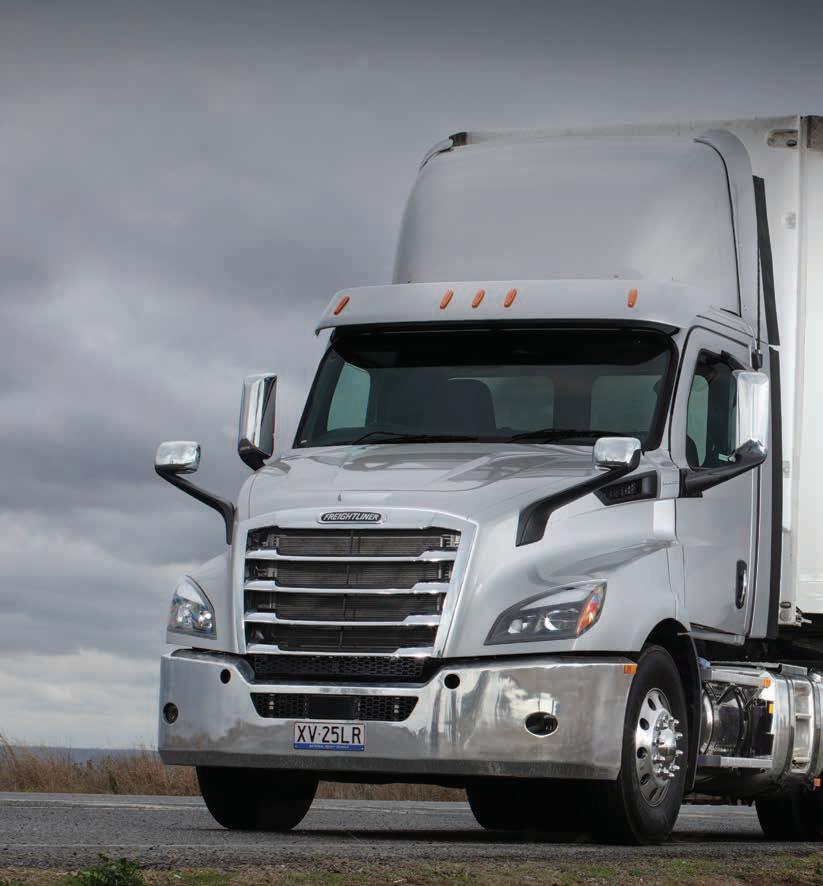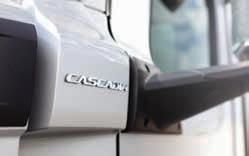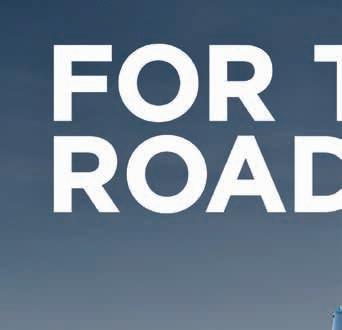
11 minute read
MAKING AMERICANS GREAT AGAIN
Road Test
Freightliner has built a great deal of anticipation around its new flagship Cascadia, a truck that the Daimler organisation has a lot riding on.
Advertisement
Then along came the Covid 19 crisis and what was supposed to be a big year for the new truck has been turned into a bit of a slow start for this important new truck.
The crisis has caused supply chain issues that slowed production from Daimler’s plant in North Carolina as well as knock on issues with shipping and other logistics just getting the trucks across the Pacific. However we are told that trucks due to be delivered in April or may are now reaching customers in Australia.
Hats off to Daimler trucks Australia though, the company has been working away within the restrictions and lock downs and just trying to get on with it the best they can given the circumstances. It is clear Daniel Whitehead and his teams including the Freightliner operation, headed up by Stephen Downes are very focussed and are happy to play the long game. They know that things hasten slowly in the truck business and they have
WITHOUT WANTING TO TAKE ANYTHING FROM THE USA’S 45TH PRESIDENT, IT STRUCK US THAT MR TRUMP’S CHARGE THAT HE WOULD ‘MAKE AMERICA GREAT AGAIN’ COULD BE REPURPOSED FOR THE HEADLINE ON THIS STORY. HERE WAS AMERICA’S BEST SELLING CLASS 8 HEAVY DUTY LINE HAUL TRUCK IN THE FORM OF DAIMLER’S US DEVELOPED AND BUILT CASCADIA, BRINGING FRESH LEVELS OF SAFETY AND EFFICIENCY TO A CONVENTIONAL TRUCK, A SECTOR LONG DOMINATED BY US DESIGNED MACHINES. THESE ‘AMERICAN’ CONVENTIONALS HAVE LOST GROUND TO THE EURO CAB OVERS AND LAGGED IN AREAS OF SAFETY AND EFFICIENCY, BUT THE ARRIVAL OF CASCADIA MAY JUST BE THE CHANCE TO REALLY MAKE AMERICAN TRUCKS GREAT AGAIN! WE TOOK ONE FOR A ROAD TEST UP THE PACIFIC HIGHWAY.

some very clear on reshaping the way Freightliner is presented to Australian truck buyers and in rebuilding the reputation of the brand which has suffered on the back of problems with early Argosy models. Despite the fact that this was a long time ago, the reality is reputations in the truck business stay tarnished for a long time and often stay for often irrational reasons.
That was then but this is now. Daimler’s resolve in keeping the wheels rolling even in the pandemic was evident in the fact that the company’s PR was persistent in making a road test program for the new truck work within the restrictions and border closures, while other truck companies simply pulled the shutters down entirely during the crisis.
So it was that we found ourselves behind the wheel of a new Cascadia for our first proper road test on Aussie soil, heading from Sydney to Murwillimbah of all places. Why Murwillimbah? Well, the original plan was to drive it to Brisbane, making is easier for Queensland based journalists could access the rig for tests. However just a few days before the hard
closure of the state border made that impossible. The alternate plan meant we would drive it to Daimler’s dealer Murwillimbah Truck Centre , and drop the truck off at Daimler’s dealer in that town before hitching a ride to Ballina and catch a flight back to Sydney from what at the time was possibly Australia’s busiest regional airport.
Still it would be a stern test of the Cascadia 116. The 116 nomenclature indicates the bumper to back of cab measurement expressed in the old imperial measurement of 116 inches (or 2950mm for those born after 1972).
The test truck was a 13 litre model using the Daimler Detroit Diesel six cylinder turbo diesel a with 505 horsepower and 2508Nm of torque on tap. The ‘little’ Detroit engine, as opposed to the bigger 16 litre with 600horsepower and 2779Nm of torque would have some hard work ahead of it on the Pacific Highway, given the B Double rig was grossing around 60 tonnes.
In reality the 116 Day cab with the 13 litre and the DT 12 automated manual transmission, although rated at 140tonnes, would most likely be the sort of spec most operators would use in single trailer configuration at around 40 tonnes, or in lighter B Double work in intra-state distribution work.
However we have been told that The 116 is being used for B Doubles on highway linehaul with 68.5 tonne tankers for Finemores, Toll and Linfox, mostly in Victoria but also in NSW milk tankers at the same weight, and also with tipper dog operators. In hilly terrain operators would probably go for the 16-litre, to avoid working the the 13-litre too hard. It’s beeen pointed out that while the 13-litre has 55hp less power than the DD15, it has the same torque output.
Our plan was to get away from Daimler’s Huntingwood dealership in Sydney’s west in the late afternoon and break the journey with an overnight stop at Nabiac where it would be easy to grab a motel bed and a meal with somewhere to park the truck, before hitting the road early next day to make Murwillimbah in good time.
This strategy meant we would have plenty of heavy traffic and stop start going to test the big load and tractability of the Cascadia. And test it we did. The usual late afternoon Pennant Hills Rd crawl lived up to expectation and time after time we found the Cascadia having to dig deep into that 13 litres to accelerate the 60 tonnes from standstill on a steepish hill to charge all of 800 metres before grinding to a halt again.
The performance was impressive, the DT12 speed shifting efficiently and smoothly up and down through the box coping with the traffic malaise admirably. It is scenarios like this that made us so thankful for a good AMT because our left leg would have been in need of physio if the task had been performed in a manual Roadranger.
Once clear of the Sydney suburbs and on the M1 the DT12 slotted up to 12th on the M1 heading to the descent onto the Hawkesbury Bridge and the Cascadia assumed a comfortable stride, humming

along with the other traffic, with the proviso that this machine was hauling 60 tonnes and the uphill stretches were a test.
There was no need for any anxiety, the13litre again dug in and ground away at the hills with a confident and hardworking feel.
Inside the Day cab of the Cascadia is comfortable and well appointed, albeit missing a bunk which is not only a good place to nap but a handy storage space inside the truck. However this spec will find favour with metro and intrastate distribution so in that sphere the bunk is an unneeded extravagance.
Climb up into the cab and slide behind the steering wheel and you instantly detect elements of family resemblance between this truck and other Daimler trucks, notably the Mercedes Benz Actros. For a start the steering wheel carries. The same appearance and control elements as the Actros, which for many companies operating Daimler fleet will mean a degree of familiarity and commonality that will make driving easier and safer. The Daimler control system lets the driver control elements of the truck controls and information systems using the steering wheel controls, infotainment touch screen, or voice control.
The system also allows the driver to scroll through the vehicle systems on the main instrument screen in front of the driver with a range of info from the vitals like engine temperature, gearbox and diff temps, fuel economy, trip meters and odo amongst other details .
The Cascadia’s adaptive cruise control is also controlled from one of the two steering wheel mounted toggles, while Bluetooth phone and radio/audio system controls are also located on the wheel. We found the entire system easy to use, simple to navigate and intuitive.
Safety has always been one of Daimler’s core tenets and the Cascadia is arguably one of the safest conventional trucks available in the world and doesn’t give anything away to the core Euro cab overs, including its siblings from Benz and the likes of Volvo, Scania, DAF and MAN.
Many operators believe conventionals offer better overall safety anyway because of the bonneted design that provides greater protection from the front. But whether that it is true or not, the Cascadia has the same levels of safety equipment as any of the cab over Euros, with standard ABS, ESP, Airbags, seatbelt pretensioners and aforementioned adaptive cruise control as well as Daimler’s version of AEB which it calls Active Brake Assist or ABA for the acronym enthusiasts.
Along with all that there is lane keep assist, side guard assist, which detects vehicles beside the truck and alerts the driver with warning sounds and lights if you indicate and start to change lanes into the path of the object.
Suffice to say the Cascadia gets the full Monty when it comes to safety equipment and engineering, which is becoming increasingly important for large fleets eager to ensure work place health and safety standards and that is sure to give

Freightliner greater entrée into those fleets for applications that require a conventional we feel certain. It may even drag some of its opponents kicking and screaming into a safer future.
As we headed north from Newcastle into the gathering darkness the cooler night air filled combustion chambers and the truck hummed along nicely. The Cascadia delivers all the ride and handling advantages of a bonneted truck with the Daimler signature safety, steering and braking performance. It really is a very pleasant truck to drive and all too soon we had pulled up for the night at Nabiac for a feed and eventually sleep after a long battle between noise of other trucks on the Pacific and the Nabiac pub’s near non-existent sound insulation.
Up before dawn the next day and on the road again the Cascadia was tracking well on the at times bumpy stretches of the Pacific, the steering delivering control and confidence all the way.
With the cruise set just below 100 the fuel consumption was pretty impressive given the weight being hauled and size of the engine with the average just shading 2km/litre.
With the excellent audio system pumping out a series of interesting podcasts and music streamed via Bluetooth from the smart phone, the trip along the now mostly dual carriageway Pacific proved an easy task for the Cascadia and it proved that drivers could cover lots of safe efficient kilometres in this truck with minimal fatigue.
The ride quality in particular was excellent, for even with a largely new motorway underneath, the road surface is still not billiard table smooth but the Cascadia has been well specced for Australian roads after the extensive test program that Daimler carried out prior to bringing the truck to market.
One US adoption that has arrived with the Cascadia is the extra mirrors positioned near the front of the bonnet. These mirrors give a wider perspective back down the truck that the door mounted mirrors can’t provide. Some have questioned them and said they don’t like the forward mounted mirrors, but we like them, having first encountered them on a Mack Anthem, in the States a couple of years back. While we like them and see value, the reality is they will probably be overtaken by Daimler’s MirrorCam as seen on the recently tested Benz Actros.
All too soon we took the left turn off the Pacific and headed back along the Tweed River for the short run into Murwillimbah and the Daimler dealer.
Sure the Cascadia was probably not specced ideally for the task of running 60 odd tonnes in B Double trim up the Pacific, but to its credit it did the job without protest and with great comfort and efficiency, particularly when it comes to fuel consumption, recording an average of just a shade over 2km/litre, which is very impressive indeed.
As we said, it been a slower start for Cascadia in Australia than Daimler probably planned for, but have no doubt, this truck will make an impact on the Australian market and we believe it will be a positive one.








The revolutionary new Freightliner Cascadia has been built following unprecedented levels of research, development and real world testing.


This is a Freightliner like none before it, delivering new levels of safety, comfort, connectivity and real cost of ownership.



So, for those wanting to be fully equipped to seize new opportunities and stay ahead of the pack, the Cascadia is here - ready and capable for what lies ahead.










